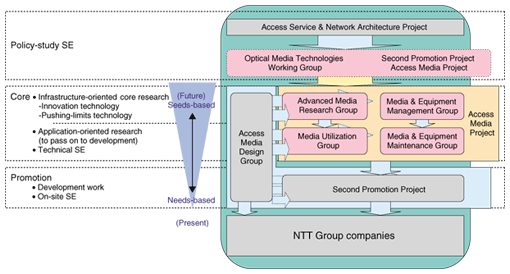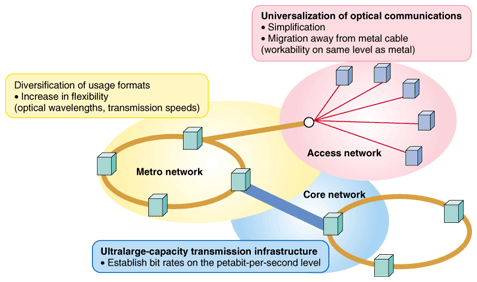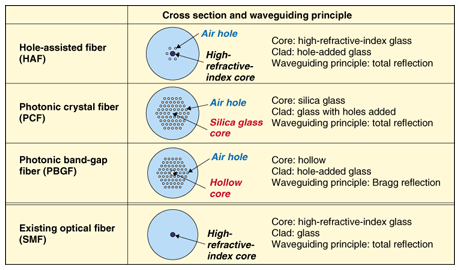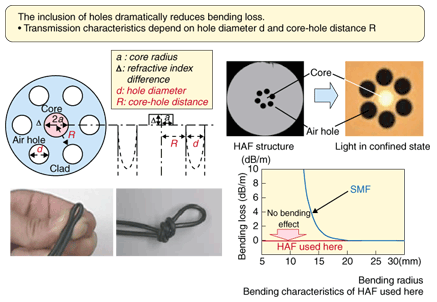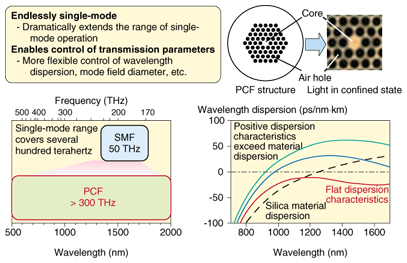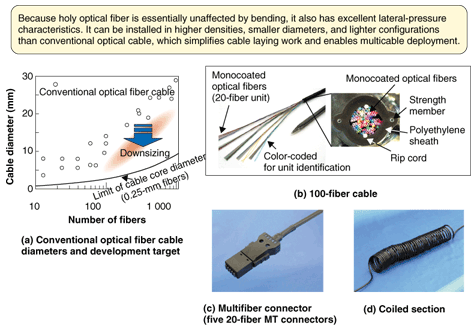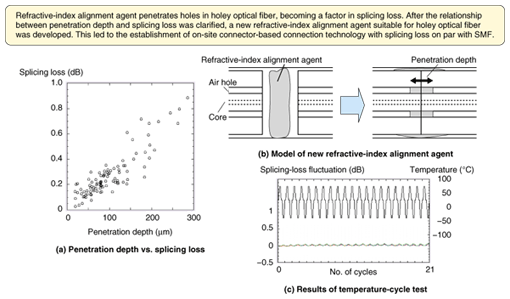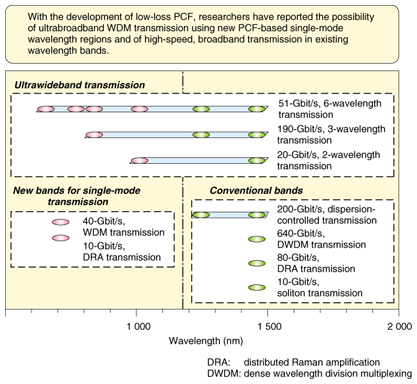 |
|||
|
|
|||
|
Special Feature: NTT Tsukuba Forum 2007 Workshop Lectures 1 Vol. 6, No. 5, pp. 1–8, May 2008. https://doi.org/10.53829/ntr200805sf1 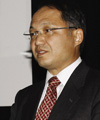 Optical Access Network Technology (Optical Media Technology) Toward Expansion of FTTHAbstractWith the aim of maintaining and operating a large number of optical facilities in an efficient manner in the rapidly approaching full-scale optical era, researchers at NTT Access Network Service Systems Laboratories are working to develop technology that can promote network opticalization and achieve large-capacity optical access. This article describes the present environment surrounding optical media technology and introduces key technologies now under development. The content of this special issue is drawn from lectures given at Tsukuba Forum 2007 held on October 25, 2007.
1. Optical media technology R&D systemThe Access Media Project in NTT Access Network Service Systems Laboratories investigates core technology for the research and development of optical media technology. It consists of four groups, each focusing on a particular set of technologies: the Advanced Media Research Group, Media & Equipment Management Group, Media Utilization Group, and Media & Equipment Maintenance Group (Fig. 1).
(1) Advanced Media Research Group This group is focusing on technology based on optical fibers having a new structure such as design technology based on holey optical fiber (hole-assisted optical fiber and photonic crystal optical fiber), technology for increasing transmission capacity by using photonic crystal optical fiber, and wavelength dispersion control technology. (2) Media & Equipment Management Group This group is focusing on optical media measurement technology such as optical oscilloscopes and high-resolution measurement technology one order of magnitude more accurate than existing systems. (3) Media Utilization Group This group is focusing on (i) optical cable design and connection technology, such as small-diameter high-density optical cable technology and sheath-attached connection technology, (ii) technology for expanding the application of bend-insensitive optical fiber to access networks, and (iii) in-house/in-building optical wiring technology. (4) Media & Equipment Maintenance Group This group is focusing on (i) optical line testing technology such as drop-interval remote testing technology, (ii) management and operations technology for optical media networks, and (iii) preventive maintenance technology, such as long-term-reliability forecasting of optical media facilities. The first two of these groups cover fields that deal with fundamental future-looking technologies focusing on innovation and pushing limits, while the last two concern application-oriented research areas for passing on researched technology to development departments. 2. Environment surrounding optical media technologyThe use of optical access is expanding rapidly. If we examine the trends in subscribers to broadband services, we can see that the number of DSL (digital subscriber line) subscribers began decreasing in fiscal year 2006, while the number of FTTH (fiber-to- the-home) subscribers has been growing unabated. Internet traffic has also been rising dramatically. It increased by about 200 Gbit/s last year and appears poised to exceed 1 Tbit/s in fiscal year 2008. One can say that the principal star in broadband services is shifting from DSL to FTTH. At the same time, the number of NTT FTTH subscribers was just short of 7.5 million as of September 2007, so to achieve NTT's target of 20 million optical subscribers by 2010, it will be necessary to promote the deployment of new lines with even more effort than before. In particular, we need to improve quick-response technologies by reducing the need for special skills in the field (skill-free procedures) and promoting do-it-yourself (DIY) techniques, and we need to lower costs and provide users with more attractive services. In parallel with these changes, the number of required facilities is rapidly increasing. For example, among the 1,650,000 km of cable owned by NTT, metal cable (at 1,091,000 km) has essentially remained unchanged for the last seven years while optical cable (at 559,000 km) is expected to continue its upward trend (figures for the end of fiscal year 2005). It is predicted, however, that the number of workers involved in field work will decrease, which indicates the need for more efficient maintenance, operation, and management. To efficiently maintain, operate, and manage a large number of facilities with relatively few people, it will, of course, be necessary to raise the reliability of facility databases and reduce the labor required for on-site operations. It will also be necessary to reduce facilities through a migration from metal-based to optical technology and promote measures for securing optical maintenance personnel. 3. Development of optical media technology (aiming for practical use)With our sights set on 20 million optical subscribers by 2010, we are taking a dual approach to researching and developing optical media technology. We call these two approaches quick response (phase 1) to support the optical mass deployment period up to 2010 and development with an eye to the future (phase 2) for the period of maintaining and operating mass optical facilities. Phase 1 will focus on (i) DIY (simplifying in-house work to the DIY level) and (ii) plug & play (simplifying deployment work through modularization). On the other hand, phase 2 will concentrate on (i) reducing the lifetime cost (lowering the costs associated with service orders, cable removal, and fault troubleshooting) and (ii) achieving paradigm shifts (achieving drastic improvements in work procedures using information technology), especially by quickly establishing technologies for:
The following technologies are nearing a practical stage. (1) Immediate databasing of indoor optical wiring work To simplify the work and management of high-density, indoor optical wiring, we attach LEDs (light emitting diodes) and RFIDs (radio frequency identification tags) to connector adaptors on optical wiring boards (such as integrated distribution modules) and RFIDs to connector plugs. Then, when connection or dismantling work is performed, the LED of the connector adaptor in question on the optical wiring board can be made to light up, providing visual navigation to the work position. We are also constructing a mechanism to prevent operational errors by comparing RFID information from connector adaptors and connector plugs and to enable RFID information to be entered into a database immediately upon completion of the work. (2) Immediate databasing of outdoor optical wiring work In the construction of optical lines and the execution of service-order work, we are making the databasing of outdoor optical facilities more efficient through the use of RFID tags and readers and mobile phones. Here, RFID tags are attached to connectors situated in the lower part of the splitter within closures and to drop-cable connectors, and the RFID information is read and registered to manage connection data. In a similar way, we also attach RFID tags to rosette connectors within houses and read and register that RFID information to enable us to perform uniform management of connection information from the splitter to the house rosette. We are constructing a mechanism for immediately databasing registered information via a mobile phone, and we are examining the use of the RFID write function to prevent erroneous registration and to store a work history that workers can reference on-site. (3) Remote testing at on-site locations We are developing a work-support system that will create an environment whereby an on-site worker can interface with separately constructed operation systems (OpSs) like a media testing OpS and equipment testing OpS without the aid of an operator. Using a mobile phone, the worker will be able to control each OpS and integrate extracted data on a listener machine, making each type of field testing more efficient. 4. Technology for R&D of optimal media technology toward the next 20 million optical subscribersThis section introduces R&D technology with a view to the full-scale optical era of the future that will follow the initial era of 20 million optical subscribers now targeted by NTT. Two major issues that can be envisioned with the large-scale deployment of optical fiber are insufficient infrastructure facilities and complex facilities management due to the coexistence of optical and metal cables. Here, there is particular concern that insufficient infrastructure facilities will be a serious problem in the full-scale optical era (optical expansion period). At the same time, the requirements for the optical-fiber cable system are becoming even more diversified (Fig. 2) and conventional single mode fiber (SMF) technology is expected to be unable to meet these requirements.
In the access network, there is a need for optical fiber technology that can help simplify optical construction technology toward the further expansion of FTTH services. Moreover, when we consider the migration from metal-based to optical services, optical fiber technology must achieve the same level of workability as metal cables. In metro networks, in addition to increasing the transmission capacity of metropolitan networks that cover entire urban areas, usage formats such as wavelength multiplexed transmission must be diversified. Optical fiber technology is expected to provide even more flexibility with respect to optical wavelengths and transmission speeds. The core network will have to take on the role of an ultralarge-capacity transmission infrastructure to support the increase in data communications in the access and metro networks. Bit rates above the terabit-per-second (Tbit/s) level will be required; that is, they must reach the petabit-per-second (Pbit/s) level. 4.1 Holey optical fiber technologyTo achieve this kind of environment, we have undertaken research and development of holey optical fiber technology, which covers three types of fiber (Fig. 3): (1) hole-assisted fiber (HAF), which features some (six) holes arranged about a fiber (existing SMF) having a highly refractive glass core resulting in a structure that can withstand bending; (2) photonic crystal fiber (PCF), which conveys light through a silica-glass core surrounded by several dozen holes, and (3) photonic band-gap fiber (PBGF), which can control the wavelength of light confined in the hollow core surrounded by several dozen holes. Of these, we are currently focusing our research efforts on HAF and PCF.
4.1.1 HAFIn HAF, the core section has the highest refractive index, the clad section has a somewhat lower one, and the air holes have the lowest refractive index. This structure results in a strong light-confining effect and improves the bending-loss characteristics dramatically (Fig. 4). Experiments have shown that the bending loss decreases exponentially with increasing hole diameter and that bending-loss characteristics improve, in particular, by more than three orders of magnitude in the value range given by d/2a ≥ 1, where d is the hole diameter and a is the core radius.
In contrast to SMF, in which bending loss increases dramatically past a bending radius of 15 mm, HAF has almost no loss even for a bending radius under 5 mm. As a result, HAF-based optical fiber cord can continue to operate even when it is bent, folded, or bundled. The loss that occurs when connecting HAF with SMF is somewhat greater than that when connecting two SMF fibers, but this loss is well within the permitted range. There was also concern that the inclusion of holes would make HAF fragile and prone to fracture, but HAF actually has the same level of mechanical strength as SMF. HAF has also been shown to have equivalent heat-cycle characteristics to SMF. 4.1.2 PCFIn PCF, there is no high-refractive-index section; instead, light is confined at the center of several dozen holes. A key feature here is that PCF can transmit light from the visible region to the infrared region in a single mode (Fig. 5). The PCF wavelength region is therefore much wider than the SMF wavelength region (1300–1650 nm). With PCF, it is also possible to alter the dispersion characteristics by modifying the size and arrangement of air holes to achieve a more flexible level of dispersion control.
Another feature of PCF is that its core can be formed using only silica glass. Forming optical fiber with a single material offers the hope of achieving the theoretical minimum loss for silica glass. In recent years, advances in fabrication technology have resulted in dramatic reductions in PCF loss, and the latest reports indicate that PCF loss characteristics are now on par with those of SMF. We can expect this trend toward lower loss in PCF to continue. With the aim of applying the above types of holey optical fiber to the access, metro, and core networks, we are developing the following technologies. 4.2 Application technologies for the access network4.2.1 Small-diameter high-density optical cableSince holey optical fiber is robust against bending, it also has superior characteristics in terms of lateral pressure, so it is much more suitable for extremely tight, high-density installations than conventional optical fiber. This feature can be exploited to achieve lightweight, small-diameter, high-density optical cables. A prototype 100-fiber cable bundles five 20-fiber units of monocoated optical fibers no thicker than a typical ballpoint pen (Fig. 6). To examine the feasibility of an optical cable with connectors at both ends, we have constructed a prototype coiled section to accommodate excess cable as needed. Furthermore, to simplify connection work, which is considered to be the biggest issue in optical cable deployment, we are developing connector technology for batch-connecting multiple fibers.
4.2.2 Refractive-index alignment agent for holey optical fiberWhen connecting holey optical fibers using connectors assembled in the field, the substance (agent) used for refractive-index alignment tends to penetrate the holes, resulting in splicing loss (Fig. 7). We examined the correspondence between the depth of agent penetration and splicing loss and verified by experiment that splicing loss increases with penetration depth. On the basis of these results, we developed a new refractive-index alignment agent suitable for holey optical fiber and confirmed that splicing loss with this new agent is on the same level as that of SMF.
4.2.3 High-accuracy optical fiber measurement technologyWhen attempting to detect a connection point by using optical measurement equipment such as an optical time domain reflectometer (OTDR), the presence of an open-end connector in the vicinity of that connection point can make it difficult to isolate the point due to the superposition of signals. In response to this problem, we have developed highly accurate measuring equipment that dramatically raises the resolution from several meters to a few centimeters. 4.3 Application technology for metro and core networks4.3.1 Transmission characteristics with PCFWe have been conducting transmission experiments on PCF from the visible region to the infrared region and investigating ultrabroadband single-mode transmission characteristics that have only been discussed in theory until now and the potential for large-capacity transmission at the petabit-per-second level, which is expected of the core network (Fig. 8). Specifically, we examined transmission characteristics using six wavelength bands in the range from 650 to 1550 nm in a transmission experiment focusing on ultrabroadband wavelengths and demonstrated the feasibility of single-mode transmission characteristics equivalent to five times that of conventional SMF. We also performed a large-capacity transmission experiment and confirmed the possibility of transmitting 16 wavelengths in the 1550-nm band each carrying 40 Gbit/s for a total transmission capacity of 640 Gbit/s.
4.3.2 Broadband dispersion controlIn dispersion-shifted fiber (DSF), the cumulative dispersion of a transmission system must be compensated for, but there is a limit on how much compensation can be applied. However, we can combine PCF and DSF to obtain superior dispersion control and achieve high-speed transmission in broadband systems. 4.3.3 High-speed signal monitoring technologyConventional oscilloscopes have been able to monitor signal wavelengths up to a rate of only 40 Gbit/s, but newly developed high-speed optical-signal monitoring technology can monitor wavelengths up to several terabits per second. This new monitoring technology can be used, for example, to measure the transmission quality of ultrahigh-speed core networks. 5. ConclusionsWhile our previous R&D efforts targeted technology for providing optical services to 20 million optical subscribers, we are already looking past this era to a genuine, full-scale optical era and are focusing our sights on technology at the next level. With the aim of achieving a next-generation optical-fiber cable system based on holey optical fiber, we are taking up even greater R&D challenges and look forward to opening the door to this new era as soon as possible. |
|||








